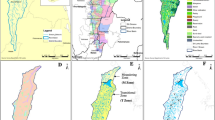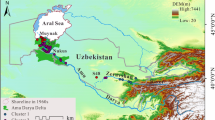Abstract
To assess the water quality characteristics of different types of water sources and find their differences in water quality, quality of drinking water sources including reservoirs, rivers, springs, and groundwater in the lower reaches of Yellow River has been seasonally investigated during 2019 and 2021. The water quality varied greatly among different water bodies, and the four types of water bodies were divided into surface (reservoirs and rivers) and groundwater (groundwater and springs) based on the water quality characteristics. Five principal components were extracted, together explaining 84% of all the variance information by log-transformed principal component analysis, which represented that anions, formation potential of disinfection by-products precursors, nutrients, and phytoplankton biomass affected the water quality of these waterbodies. The matter sources of surface water and groundwater were quite different, with dominant by organic compounds and inorganic matters, respectively. However, the similar humus carbon-to-nitrogen ratio (HS-C/N) values indicated that the organic matter in groundwater is affected to a certain extent by the replenishing surface water. In the aspect of inorganic ions, these waterbodies were more affected by Na+–Cl−–SO42− in the wet season, while Ca2+–HCO3−–CO32− in the dry season. Gibbs diagram suggested that the anions and cations were mainly contributed by atmospheric precipitation for the surface water, while they were mainly derived from rock weathering for the groundwater. It is hoped that this study will help to evaluate the pollution risk and the feasibility of long-term implementation of artificial source remediation projects.





Similar content being viewed by others
Data availability
The data are available from the corresponding author on reasonable request.
References
Andres M, Paul S (2018) Groundwater chemistry and the Gibbs diagram. Appl Geochem 97:209–212
Atasoy AD, Yesilnacar MI (2009) Effect of high sulfate concentration on the corrosivity: a case study from groundwater in Harran Plain, Turkey. Environ Monit Assess 166:595–607
Ding G, Chen G, Liu Y, Li M, Liu X (2020) Occurrence and risk assessment of fluoroquinolone antibiotics in reclaimed water and receiving groundwater with different replenishment pathways. Sci Total Environ 738:139802–139802
Ekholm P, Lehtoranta J, Taka M, Sallantaus T, Riihimki J (2020) Diffuse sources dominate the sulfate load into Finnish surface waters. Sci Total Environ 748:141297–141297
Ganegoda G, Manage P, Pathirage S (2018) Evaluation of well water quality with special emphasis on principal component analysis (PCA) at Maharagama, Sri Lanka. J Ecotechnol Res 18:47–57
Gibbs RJ (1970) Mechanisms controlling world water chemistry. Science 170:1088–1090
Gibrilla A, Fianko JR, Ganyaglo S, Adomako D, Zakaria N (2020) Nitrate contamination and source apportionment in surface and groundwater in Ghana using dual isotopes (15N and 18O–NO3) and a Bayesian isotope mixing model. J Contam Hydrol 233:103658–103658
Hood E, Williams MW, Mcknight DM (2005) Sources of dissolved organic matter (DOM) in a Rocky Mountain stream using chemical fractionation and stable isotopes. Biogeochemistry 74:231–255
Hou W, Sun S, Wang M, Li X, Zhang N, Xin X, Sun L, Li W, Jia R (2016) Assessing water quality of five typical reservoirs in lower reaches of Yellow River, China: using a water quality index method. Ecol Ind 61:309–316
Hou W, Sun S, Wang M, Gu B, Li X, Zhang C, Jia R (2020) Variations in stable carbon and nitrogen isotopes of particulate organic matter in surface waters of water-receiving area of Eastern Route of South-to-North Water Transfer Project, China. Environ Sci Pollut Res 27:2805–2818
Jeelani GH, Bhat NA, Shivanna K, Bhat MY (2011) Geochemical characterization of surface water and spring water in SE Kashmir Valley, western Himalaya: implications to water–rock interaction. J Earth Syst Sci 120:921–932
Kalff J (2012) Limnology: inland water ecosystems. McGill University Press, Montreal
Li S, Lu XX, Min H, Yue Z, Bei R, Li L, Ziegler AD (2011) Major element chemistry in the upper Yangtze River: a case study of the Longchuanjiang River. Geomorphology 129:29–42
Li ZJ, Li ZX, Fan XJ, Wang Y, Song LL, Gui J, Xue J, Zhang BJ, Gao WD (2020) Transformation mechanism of ions on different waters in alpine region [J]. Chemosphere 248:126082
Liu J, Gao Z, Wang M, Li Y, Ma Y (2019) Hydrochemical and isotopic characteristics of surface water in the Lhasa River basin. Arab J Geosci 12:520
Luo J, Fu Q, Zheng B, Zhao X, Liu Y, Huang M (2012) Disinfection by-products formation potential of dissolved organic matter fractions isolated from algae bloom water. J Basic Sci Eng 20:210–218 (in Chinese)
Moon JW, Paradis CJ, Joyner DC, Netzer FV, Hazen TC (2020) Characterization of subsurface media from locations up- and down-gradient of a uranium-contaminated aquifer. Chemosphere 255:126951
More S, Dhakate R, Ratnalu GV, Machender G (2021) Hydrogeochemistry and health risk assessment of groundwater and surface water in fluoride affected area of Yadadri-Bhuvanagiri District, Telangana State, India. Environ Earth Sci 80:262
Pang HC, Fang JJ, Liu YF, Cai HS, Liu FL, Gao TZ (2018) Isotope signatures and hydrochemistry as tools in assessing nitrate source in shallow aquifer of Hebei, China. Bull Chem Commun 50:161–170
Pant RR, Zhang F, Rehman FU, Wang G, Ye M, Tang H (2018) Spatiotemporal variations of hydrogeochemistry and its controlling factors in the Gandaki River Basin, Central Himalaya Nepal. Sci Total Environ 622:770–782
Popov M, Isakovski MK, Jazi JM, Tubi A, Agbaba J (2020) Fate of natural organic matter and oxidation/disinfection by-products formation at a full-scale drinking water treatment plant. Environ Technol 42:1–12
SEPA, S.o.E.P.A. (2002) Monitoring and analysis method of water and wasterwater. Chinese Environmental Science, Beijing
Setia R, Lamba S, Chander S, Kumar V, Dhir N, Sharma M, Singh RP, Pateriya B (2021) Hydrochemical evaluation of surface water quality of Sutlej river using multi-indices, multivariate statistics and GIS. Environ Earth Sci 80:565
Srivastava AK, Parimal PS (2020) Source rock weathering and groundwater suitability for irrigation in Purna alluvial basin, Maharashtra, central India. J Earth Syst Sci 129:52
Vall SA, Ayora C, Manzano M, Bea SA, Martínez S (2020) The role of loess weathering in the groundwater chemistry of the Chaco-Pampean Plain (Argentina). J Hydrol 587:124984
Vasilache N, Diacu E, Vasile GG, Modrogan C, Pirvu F (2020) Groundwater quality assessment for drinking and irrigation purpose using GIS, piper diagram and water quality index. J Ecol Environ Sci 2:109–117
Winter JG, Landre A, Lembcke D, O’Connor EM, Young JD (2011) Increasing chloride concentrations in Lake Simcoe and its tributaries. Water Qual Res J Can 46:157–165
Xu X, Wang B, Shen J, Kang J, Zhao S, Yan P, Chen Z (2022) Characteristics and disinfection by-product formation potential of dissolved organic matter in reservoir water in cold area. Chemosphere 301:134769
Zhang Q, Wang S, Yousaf M, Wang S, Nan Z, Ma J, Wang D, Zang F (2018) Hydrochemical characteristics and water quality assessment of surface water in the northeast Tibetan Plateau of China. Water Sci Technol Water Supply 18:1757–1768
Zhang Y, Bambrick H, Mengersen K, Tong S, Hu W (2019) Using big data to predict pertussis infections in Jinan city, China: a time series analysis. Int J Biometeorol 64:95–104
Zhu B, Yang X (2007) Chemical characteristics and origin of natural water bodies in the Taklimakan Desert. Sci Bull 52:1561–1566
Zhu B, Yu J, Qin X, Rioual P, Zhang Y, Liu Z, Yan M, Li H, Ren X, Xiong H (2013) Identification of rock weathering and environmental control in arid catchments (northern Xinjiang) of Central Asia. J Asian Earth Sci 66:277–294
Acknowledgements
This work was financially supported by the Focus on research and development plan in Shandong Province (2020CXG011406), Natural Science Foundation of Shandong Province (ZR2021ME166), and National Natural Science Foundation of China (51808512).
Funding
Funding was supported by Natural Science Foundation of Shandong Province (ZR2021ME166), National Natural Science Foundation of China (51808512), Focus on research and development plan in Shandong Province (2020CXG011406).
Author information
Authors and Affiliations
Contributions
Wei Hou and Zhenxing Yao wrote the main manuscript text, and Fang Hu collected water samples and analyzed the data. Angzhen Li, Shaohua Sun and Mingquan Wang provided advice and suggestions for the implementation of this work. Juibao Jia All authors reviewed the manuscript.
Corresponding author
Ethics declarations
Conflict of interest
The authors declare no competing interests.
Additional information
Publisher's Note
Springer Nature remains neutral with regard to jurisdictional claims in published maps and institutional affiliations.
Rights and permissions
Springer Nature or its licensor (e.g. a society or other partner) holds exclusive rights to this article under a publishing agreement with the author(s) or other rightsholder(s); author self-archiving of the accepted manuscript version of this article is solely governed by the terms of such publishing agreement and applicable law.
About this article
Cite this article
Wei, H., Fang, H., Zhenxing, Y. et al. Differences in water quality of four different types of water sources in the lower reaches of the Yellow River in China. Environ Earth Sci 82, 518 (2023). https://doi.org/10.1007/s12665-023-11198-2
Received:
Accepted:
Published:
DOI: https://doi.org/10.1007/s12665-023-11198-2




